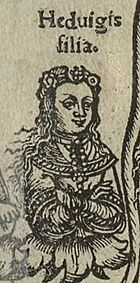Hedwig Jagiellon (1408–1431) facts for kids
Quick facts for kids Hedwig Jagiellon |
|
|---|---|

Hedwig depicted posthumously in 1521
|
|
| Born | 8 April 1408 Kraków, Kingdom of Poland |
| Died | 8 December 1431 (aged 23) Kraków, Kingdom of Poland |
| Burial | Wawel Cathedral, Wawel Hill, Kraków |
| Dynasty | Jagiellon |
| Father | Władysław II Jagiełło |
| Mother | Anna of Cilli |
Hedwig Jagiellon (Polish: Jadwiga Jagiellonka; Lithuanian: Jadvyga Jogailaitė) was a Polish and Lithuanian princess. She was born on April 8, 1408, in Kraków, which was then part of the Kingdom of Poland. As the only child of Władysław II Jagiełło, the King of Poland and Supreme Duke of Lithuania, Hedwig was seen as the future ruler of both lands for most of her life.
However, after her father had sons in 1424 and 1427, Hedwig's claim to the throne became less certain. She passed away in 1431.
Contents
Hedwig's Family and Early Life
Hedwig was the only daughter of Władysław Jagiełło, the King of Poland and Supreme Duke of Lithuania. Her mother was Anna of Cilli, who was the daughter of William, Count of Cilli. Anna of Cilli's mother was Anna of Poland, Countess of Celje, who was a granddaughter of King Casimir III of Poland. This meant Anna of Cilli had a strong connection to the old Polish royal family, the Piast dynasty.
King Jagiełło married Anna of Cilli in 1402. This marriage helped him strengthen his position as King of Poland after his first wife, Jadwiga of Poland, passed away. Hedwig, born in 1408, was named after Queen Jadwiga.
Since it became clear that her mother, Anna of Cilli, would not have more children, Hedwig was officially declared the likely heir to the throne in 1413. Queen Anna died in 1416, making Hedwig King Jagiełło's only living child. After Anna's death, Hedwig was raised by her stepmothers. Her father married Elisabeth of Pilica in 1417 and then Sophia of Halshany in 1422.
Plans for Hedwig's Marriage
Before King Jagiełło had sons, Hedwig's marriage was very important for Polish politics. Her husband would likely become the next King of Poland after Jagiełło.
First Marriage Proposal: Bogislaw IX
In 1419, King Jagiełło met with Eric of Pomerania, who was the King of Sweden, Norway, and Denmark. They discussed forming an alliance against the Teutonic Knights, a powerful military order. King Eric suggested that Hedwig marry his cousin, Bogislaw IX, Duke of Pomerania, who was about eight or nine years old at the time. However, this alliance and marriage plan did not happen.
Second Marriage Proposal: Frederick II
On April 12, 1421, Hedwig became engaged to Frederick II, Margrave of Brandenburg. He was the second son of Frederick I, Elector of Brandenburg. His family wanted an alliance with Poland because they had a long-standing conflict with Pomerania.
According to their agreement, Hedwig and Frederick II would marry when he turned 14 in 1427. Five years after their marriage, Frederick II could become King of Poland and Grand Duke of Lithuania. The young prince was supposed to live in Poland to learn the language and customs. This agreement would be canceled if King Jagiełło had sons who survived.
Changes and Challenges
Ten months later, King Jagiełło married Sophia of Halshany, who was only a few years older than Hedwig. Frederick I was not happy about this marriage. He sent his son, Frederick II, to Kraków to be with Hedwig. Tensions grew because Brandenburg did not send troops to help Poland in the Gollub War against the Teutonic Knights.
Sigismund, Holy Roman Emperor, also tried to stop the marriage. Meanwhile, King Eric of Scandinavia again suggested an alliance with Poland and Pomerania against Brandenburg. Despite these pressures, King Jagiełło did not cancel the agreement. In 1424, fearing for Frederick II's safety, Grand Duke Vytautas took the prince from Kraków to Lithuania.
In October 1424, Queen Sophia gave birth to King Jagiełło's first son, Władysław III of Poland. Even with the birth of a son, Frederick II still wanted to marry Hedwig. Some Polish nobles supported Hedwig and her future husband becoming rulers, instead of King Jagiełło's sons by Queen Sophia, who were not related to the old Piast dynasty.
Hedwig's maternal grandmother, Anna of Poland, Countess of Celje, passed away in 1425. This left Hedwig with fewer close relatives to support her in the power struggles with Queen Sophia. Because of the uncertainty about who would inherit the throne, Hedwig's marriage was delayed.
Hedwig became ill for about a year and passed away in December 1431. She was buried in the Wawel Cathedral. There were rumors that Queen Sophia had poisoned the princess, but Queen Sophia had to defend herself against these claims. It is believed that Frederick II was truly saddened by Hedwig's death.

